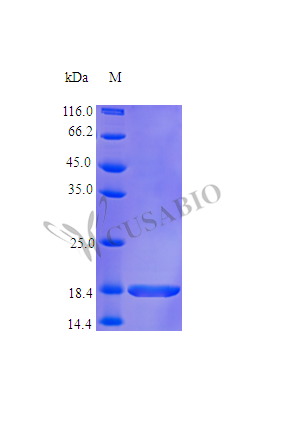Recombinant Human Interleukin-36 gamma protein (IL36G) is expressed in E. coli, covering the full-length sequence from 1 to 169 amino acids. This tag-free protein achieves high purity levels exceeding 95%, as confirmed by SDS-PAGE analysis. The protein appears to be biologically active, with specific activity validated through functional ELISA, demonstrating its ability to bind recombinant human IL-1 Rrp2 Fc Chimera. Endotoxin levels remain under 1.0 EU/µg, ensuring suitability for research applications.
Interleukin-36 gamma (IL-36γ) belongs to the interleukin-1 family and plays a role in immune response regulation. It participates in inflammatory pathways, contributing to the activation of immune cells such as T-cells and dendritic cells. Research on IL-36γ may be essential for understanding its function in immune processes and its potential implications in inflammatory diseases.
Potential Applications
Note: The applications listed below are based on what we know about this protein's biological functions, published research, and experience from experts in the field. However, we haven't fully tested all of these applications ourselves yet. We'd recommend running some preliminary tests first to make sure they work for your specific research goals.
1. IL-36γ/IL-1Rrp2 Receptor Binding Studies
This recombinant IL-36γ protein is confirmed to have receptor binding activity (binding to IL-1Rrp2 Fc chimera at 0.15-5 μg/mL) and is suitable for studying binding kinetics and affinity with its cognate receptor. Surface plasmon resonance, bio-layer interferometry, or ELISA-based assays can reliably characterize binding parameters. The high purity (>95%) and low endotoxin levels ensure minimal interference in sensitive binding assays. However, since activity validation is based solely on binding assays rather than functional cellular responses, researchers should confirm signaling competence in cellular assays for complete functional characterization.
2. Inflammatory Pathway Signaling Research
The protein can be used in cell-based assays studying inflammatory signaling, but its ability to activate downstream signaling pathways requires experimental confirmation. While the demonstrated receptor binding suggests potential signaling capability, researchers should first validate that this E. coli-expressed IL-36γ can indeed activate NF-κB, MAPK pathways, or cytokine production in relevant cell types before concluding inflammatory signaling mechanisms.
3. Antibody Development and Validation
This high-purity, tag-free IL-36γ protein serves as an excellent antigen for antibody development. The confirmed receptor binding activity indicates proper conformational epitopes, making it suitable for generating antibodies that recognize the native protein. However, antibodies should be validated for their ability to neutralize IL-36γ biological function using cellular assays, as binding activity alone doesn't guarantee functional neutralization capability.
4. Protein-Protein Interaction Screening
The protein can be used in interaction studies, but caution is needed when identifying novel binding partners beyond IL-1Rrp2. While the established IL-1Rrp2 binding provides a positive control, any newly identified interactors should be validated with additional methods, as E. coli expression lacks mammalian post-translational modifications that might affect some interactions.
5. Structural and Biophysical Characterization Studies
This protein is suitable for biophysical analyses (circular dichroism, dynamic light scattering) to assess folding and stability. However, for high-resolution structural studies (X-ray crystallography, cryo-EM), the protein may require optimization as E. coli expression might not yield the homogeneous conformation needed for crystallization. The receptor binding activity suggests proper folding, but structural studies would benefit from confirmation of monodispersity and stability under crystallization conditions.
Final Recommendation & Action Plan
This E. coli-expressed Human IL-36γ protein is a valuable tool for receptor binding studies and antibody development, with its biological activity confirmed through specific receptor interaction assays. For immediate use, prioritize binding kinetic studies with IL-1Rrp2 and antibody generation applications. For signaling studies, first validate the protein's ability to activate downstream pathways in relevant cell models before proceeding with extensive mechanistic research. For structural studies, perform initial biophysical characterization to assess suitability for high-resolution methods. While the demonstrated receptor binding indicates proper folding, researchers should note that the functional validation is limited to binding assays rather than cellular responses. For all applications, include appropriate controls and consider complementary experiments with mammalian-expressed IL-36γ when investigating aspects that might be affected by the absence of eukaryotic post-translational modifications.






